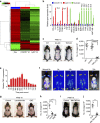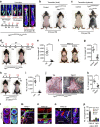Macrophages induce AKT/β-catenin-dependent Lgr5+ stem cell activation and hair follicle regeneration through TNF
- PMID: 28345588
- PMCID: PMC5378973
- DOI: 10.1038/ncomms14091
Macrophages induce AKT/β-catenin-dependent Lgr5+ stem cell activation and hair follicle regeneration through TNF
Abstract
Skin stem cells can regenerate epidermal appendages; however, hair follicles (HF) lost as a result of injury are barely regenerated. Here we show that macrophages in wounds activate HF stem cells, leading to telogen-anagen transition (TAT) around the wound and de novo HF regeneration, mostly through TNF signalling. Both TNF knockout and overexpression attenuate HF neogenesis in wounds, suggesting dose-dependent induction of HF neogenesis by TNF, which is consistent with TNF-induced AKT signalling in epidermal stem cells in vitro. TNF-induced β-catenin accumulation is dependent on AKT but not Wnt signalling. Inhibition of PI3K/AKT blocks depilation-induced HF TAT. Notably, Pten loss in Lgr5+ HF stem cells results in HF TAT independent of injury and promotes HF neogenesis after wounding. Thus, our results suggest that macrophage-TNF-induced AKT/β-catenin signalling in Lgr5+ HF stem cells has a crucial role in promoting HF cycling and neogenesis after wounding.
Conflict of interest statement
The authors declare no competing financial interests.
Figures






References
-
- Oshima H., Rochat A., Kedzia C., Kobayashi K. & Barrandon Y. Morphogenesis and renewal of hair follicles from adult multipotent stem cells. Cell 104, 233–245 (2001). - PubMed
-
- Stenn K. S. & Paus R. Controls of hair follicle cycling. Physiol. Rev. 81, 449–494 (2001). - PubMed
-
- Morris R. J. et al.. Capturing and profiling adult hair follicle stem cells. Nat. Biotechnol. 22, 411–417 (2004). - PubMed
-
- Jaks V. et al.. Lgr5 marks cycling, yet long-lived, hair follicle stem cells. Nat. Genet. 40, 1291–1299 (2008). - PubMed
-
- Snippert H. J. et al.. Lgr6 marks stem cells in the hair follicle that generate all cell lineages of the skin. Science 327, 1385–1389 (2010). - PubMed
Publication types
MeSH terms
Substances
LinkOut - more resources
Full Text Sources
Other Literature Sources
Medical
Molecular Biology Databases
Research Materials
Miscellaneous

